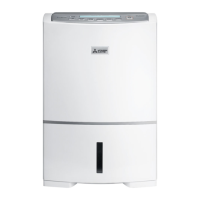
Do you have a question about the Mitsubishi Electric MJ-EV38HR-A and is the answer not in the manual?
| Model | MJ-EV38HR-A |
|---|---|
| Dehumidification Capacity (30°C, 80% RH) | 38 L/day |
| Dehumidification Capacity (27°C, 60% RH) | 20 L/day |
| Water Tank Capacity | 5.5 L |
| Operating Temperature | 5 - 35 °C |
| Air Flow (High) | 230 m³/h |
Guidance on using the unit for drying laundry, including automatic and continuous operation.
Information on selecting modes like ECO AUTO, EASY, HIGH, and LOW for dehumidification.
Instructions for using the MILDEW GUARD mode to prevent mold growth.
Details on operating the unit's air purifying function.
Answers to common user queries regarding dehumidifier operation and performance.
Explanation of warning and caution symbols used in the manual and on the unit.
Essential warnings regarding electrical safety, cord handling, and unit modification.
Guidelines on suitable operating environments, avoiding water contact, sunlight, and enclosed spaces.
Precautions for unit placement, movement, and avoiding damage from tipping or improper handling.
Advice on hanging clothes, spacing, and ventilation for efficient laundry drying.
Optimal positioning of the dehumidifier relative to laundry for best airflow.
Using the louvre to direct airflow effectively over laundry.
Recommendations for room temperature and closing doors/windows during drying.
Explanation of how room temperature affects dehumidifier performance and air temperature.
Detailed explanation of the cooling coil, water tank, and re-heating coil mechanism.
Information on the inverter's role in controlling compressor speed for efficiency.
The optimal room temperature range for effective dehumidifier operation.
Reasons why the unit's humidity reading may differ from a separate hygrometer.
Explanation of the automatic defrosting process when the unit operates in cold conditions.
Identification and function of parts located on the front of the unit.
Identification and function of parts located on the back of the unit.
Details about the PM2.5 filter, its structure, and capabilities.
Information regarding accessories supplied with or available for the unit.
Description of the switches and buttons on the control panel.
Explanation of the Inverter indicator light's meaning.
Explanation of indicators and information displayed on the LCD screen.
Details on how the humidity indicator displays current and set humidity levels.
Step-by-step guide for installing the PM2.5 filter before first use.
Instructions for properly inserting the water tank into the unit.
Guidance on safely plugging the power cord into a socket.
Recommendations for safely carrying and moving the dehumidifier.
How the Intelligent Laundry mode automatically estimates drying time.
Information on operating times and conditions for the Intelligent Laundry mode.
Instructions on how to stop the laundry drying operation.
Tips for spacing and hanging clothes to maximize drying efficiency.
Correct placement of the unit to ensure air blows towards the laundry.
Using the louvre to direct air to all parts of the laundry.
Recommendations for room environment, including temperature and ventilation.
How to cycle through and select different dehumidifying modes (EASY, ECO AUTO, HIGH, LOW).
Instructions for setting the desired humidity level, primarily in ECO AUTO mode.
How to select and adjust the louvre's swing direction.
How to stop the dehumidifying operation.
Details on the EASY mode, which operates intermittently to relieve dampness.
Explanation of ECO AUTO mode for maintaining humidity levels.
Information on the HIGH mode for strong dehumidification with continuous airflow.
Details on the LOW mode for dehumidifying with reduced blower sound.
How this mode suppresses mildew growth by removing residual moisture.
Recommended placement for the unit when using the Mildew Guard function.
Factors affecting the results and optimal conditions for mildew prevention.
The principle behind mildew suppression through drying.
Operation of the air purifier function and filter system.
Details about the PM2.5 filter being a consumable part requiring regular replacement.
Instructions on when and how to replace the PM2.5 filter.
Explanation of the louvre's adjustable swing settings for different purposes.
How to stop the louvre at a desired angle.
Using the rear swing mode to direct air to the back of the unit.
Using the upward swing mode for air distribution.
Using the wide swing mode to cover the entire room.
Instructions for setting the timer to turn the unit off automatically.
Instructions for setting the timer to turn the unit on automatically.
How to cancel or disable timer settings.
How to activate the automatic drying cycle after use.
How to start the drying inside operation manually when the unit is off.
Instructions on how to stop the drying inside operation and resume normal use.
What happens when the water tank is full and how the indicator lights up.
Step-by-step instructions for safely removing and emptying the water tank.
Ensuring the tank lid and guard are securely attached before reinserting.
Information on attaching a hose for continuous drainage and necessary precautions.
Detailed steps for installing the hose and ensuring proper drainage.
Schedule and instructions for cleaning the rear air intake, pre-filter, and sensor.
Instructions for cleaning the water tank and main body with a soft cloth.
Performing the DRYING INSIDE operation before storage to prevent mildew.
Instructions for storing the power cord safely.
Ensuring the water tank is completely drained before storing the unit.
Cleaning the pre-filter and PM2.5 filter before storing the unit.
Guidelines for covering and storing the unit in a suitable location.
Cause and remedy for the unit blowing warm air.
Troubleshooting low water collection and minimal dehumidifying effects.
Diagnosing and resolving issues where the unit does not operate or the louvre is stuck.
Reasons for the unit stopping unexpectedly during operation.
Troubleshooting the unit stopping shortly after starting operation.
Resolving problems related to the full tank indicator and water tank insertion.
Troubleshooting the unit continuing operation after power is turned off.
Addressing issues where the desired humidity level is not being reached.
Explanation for differences in humidity readings between the unit and other hygrometers.
Troubleshooting problems with the louvre's movement or position.
Addressing the issue where the louvre remains open after the unit stops.
Information about liquid or white residue found in the water tank.
Troubleshooting black residue inside the water tank and lid.
Causes and remedies for loud or reverberating operating noise.
Troubleshooting sudden increases in operating sound volume.
Explanation of the simmering sound produced by refrigerant flow.
Troubleshooting intermittent buzzing sounds or compressor startup issues.
Addressing odors that may be present when the unit is first used.
Troubleshooting abnormal heat generated by the power plug or socket.
Information about error messages displayed on the unit.
Explanation of specific error codes and their corresponding remedies.
Technical specifications including model number and power supply requirements.
Details on dehumidifying capacity, power consumption, and water tank capacity.
Physical specifications of the unit, including height, width, depth, and weight.
Proper procedures for disposing of the PM2.5 filter according to local regulations.
Guidelines for disposing of the dehumidifier unit without disassembly.
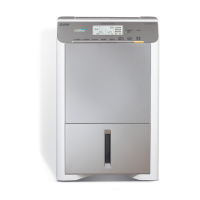
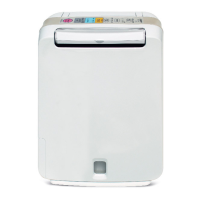

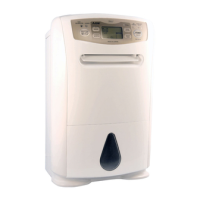
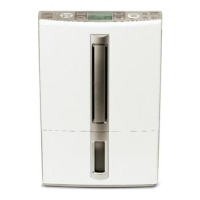
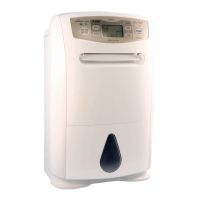
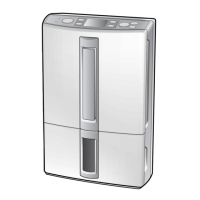
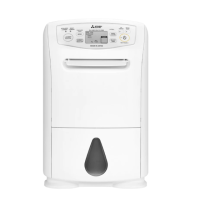
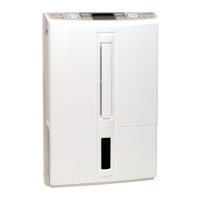
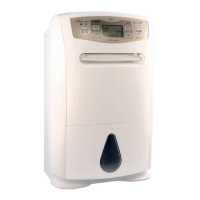

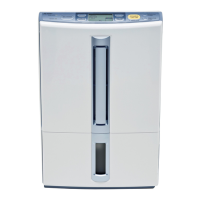
